Performance Works
Jethro Cooke – Asterism
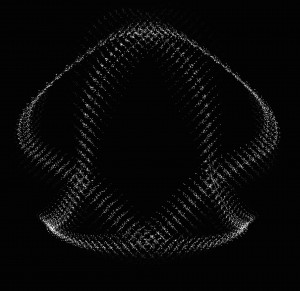 A pair of white pixels dance, draw pretty patterns and freak out to fun sounds in this carefully choreographed conversation between electronic music and image.
A pair of white pixels dance, draw pretty patterns and freak out to fun sounds in this carefully choreographed conversation between electronic music and image.
Inspired by oscilloscope art, Asterism uses a wave-terrain synthesis engine to generate complex sounds with dynamic visualisations from simple audio signals.
Biography
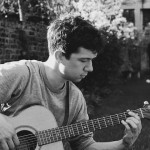 Jethro grew up in a small Devon town collecting field recordings, building crude instruments and busking. He now studies at the Guildhall School, London, where he makes art-folk, abstract EDM, and other electronic musics on his computer.
Jethro grew up in a small Devon town collecting field recordings, building crude instruments and busking. He now studies at the Guildhall School, London, where he makes art-folk, abstract EDM, and other electronic musics on his computer.
His live work may or may not feature responsive projections, proximity sensors and/or dramatically lit tape machines.
Jethro also writes music for animations, films and theatre, works as an arranger and sound-designer, plays folk tunes on his guitar, and teaches people how to use audio software.
Alexander Dupuis/Kristin Hayter – #000000
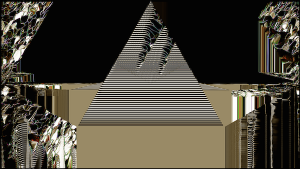 #000000 (pronounced RGB black) is an audiovisual performance duo based in Providence, Rhode Island, consisting of Kristin Hayter on vocals/electronics and Alexander Dupuis on video. #000000 extends the psychedelic conventions of liquid light show performance with an expanded range of aesthetics and techniques, encompassing liturgical chants and black metal as well as flicker films and glitch art. The performance unfolds as an improvisational conversation, avoiding predetermined mappings in order to rely on the responsiveness of the two players. Together the voice and video amass a dense swathe of intertwining texture and ambience, a conduit of alien images and unspoken voices.
#000000 (pronounced RGB black) is an audiovisual performance duo based in Providence, Rhode Island, consisting of Kristin Hayter on vocals/electronics and Alexander Dupuis on video. #000000 extends the psychedelic conventions of liquid light show performance with an expanded range of aesthetics and techniques, encompassing liturgical chants and black metal as well as flicker films and glitch art. The performance unfolds as an improvisational conversation, avoiding predetermined mappings in order to rely on the responsiveness of the two players. Together the voice and video amass a dense swathe of intertwining texture and ambience, a conduit of alien images and unspoken voices.
Biographies
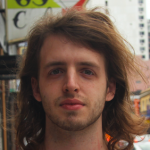 Alexander Dupuis creates time-based works using sound, light, and movement. His practice draws on the fields of experimental music/film/animation, particularly those threads that posit alternative notions of space and time to that of our three-dimensional, linear perception. Real-time animations, cross-modal translations, and feedback feature prominently in his approach, which manifests in live performances as well as fixed-media pieces. He performs as a guitarist, as well as with instruments of his own design, and has played in various guises across the United States, Canada, and Europe. He received his MA in Digital Musics from Dartmouth College in 2012, and is currently pursuing a PhD in the MEME program at Brown University.
Alexander Dupuis creates time-based works using sound, light, and movement. His practice draws on the fields of experimental music/film/animation, particularly those threads that posit alternative notions of space and time to that of our three-dimensional, linear perception. Real-time animations, cross-modal translations, and feedback feature prominently in his approach, which manifests in live performances as well as fixed-media pieces. He performs as a guitarist, as well as with instruments of his own design, and has played in various guises across the United States, Canada, and Europe. He received his MA in Digital Musics from Dartmouth College in 2012, and is currently pursuing a PhD in the MEME program at Brown University.
 Kristin Hayter is an interdisciplinary artist living and working in Providence, Rhode Island. She holds a BFA in Writing from The School of the Art Institute of Chicago and is currently a graduate student in Brown University’s Literary Arts Program, concentrating in Digital Language Arts. Kristin has performed and shown work in the Bay Area, Chicago, New York, Providence, and Prague. The voice and the voicing body are central to her practice, and her work often uses digital and analog processing to create richly-textured works that utilize the voice exclusively. Though Kristin is a classically trained soprano, she has studied voice across a wide spectrum of styles and techniques, including traditional Bulgarian polyphony, contemporary breath work, and the extended technique of hardcore, grindcore, and black metal.
Kristin Hayter is an interdisciplinary artist living and working in Providence, Rhode Island. She holds a BFA in Writing from The School of the Art Institute of Chicago and is currently a graduate student in Brown University’s Literary Arts Program, concentrating in Digital Language Arts. Kristin has performed and shown work in the Bay Area, Chicago, New York, Providence, and Prague. The voice and the voicing body are central to her practice, and her work often uses digital and analog processing to create richly-textured works that utilize the voice exclusively. Though Kristin is a classically trained soprano, she has studied voice across a wide spectrum of styles and techniques, including traditional Bulgarian polyphony, contemporary breath work, and the extended technique of hardcore, grindcore, and black metal.
Robert Baldock, Emma Bowen, Sharon Quigley – Sonic Lantern: Tender Buttons (excerpts) (Gertrude Stein, 1914)
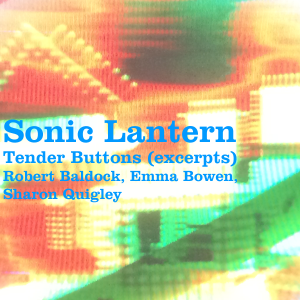 The Sonic Lantern re-imagines the magic lantern for the age of electronics. It’s a multi-viewpoint, analogue story-telling system which explores the intersections between theatre, cinema and video art and which allows performers to spontaneously create dramatic visual responses to sonic source material. This sound source is not just used to inform the performer’s response, however. It also plays a direct role in the performance as it is used to modulate the visual aspects of the system.
The Sonic Lantern re-imagines the magic lantern for the age of electronics. It’s a multi-viewpoint, analogue story-telling system which explores the intersections between theatre, cinema and video art and which allows performers to spontaneously create dramatic visual responses to sonic source material. This sound source is not just used to inform the performer’s response, however. It also plays a direct role in the performance as it is used to modulate the visual aspects of the system.
Getrude Stein’s collection of prose poetry from 1914, Tender Buttons, could be described as cubism applied to the written form. It uses a wide variety of domestic objects, food and domestic spaces as the basis of a series of fragmented and impressionistic reflections. The pieces are also perfect examples of what poet Edith Sitwell would later define as ‘abstract poetry’, where the sound of the words often carries more weight than the meaning of the words.
The multi-faceted nature of Tender Buttons makes it the perfect source material for the Sonic Lantern and so for Seeing Sound 4 the Sonic Lantern will be used to perform a response to this collection of poems.
The pre-recorded excerpts from Tender Buttons will be read by participants from Glasgow-based arts charity Project Ability.
Biographies
Robert Baldock is a sound artist, ‘old and new media’ artist and experimental musician. His primary interest is in exploring the element of chance in electronic music and video. His work is generally improvisational in nature, using a combination of performance systems built with Max/MSP and analogue audio and video synthesis hardware. His most recent pieces, Synaesthetic Sequencer and the Sonic Lantern explore the inter-relationships between sound and vision, both being playful and highly interactive.
Emma Bowen makes work as an artist and filmmaker in educational, community, health care and therapy settings and often works alongside other creative practitioners to facilitate and document participatory and collaborative-based art sessions.
She has made observational documentaries promoting the benefits of arts on the mind (visual arts, music and drama) in stroke recovery/therapy and mental health.
In her own practice she explores sound, play, self-expression and cognition with experimental and improvised performance, sound and video.
Sharon Quigley is an Edinburgh-based visual artist whose practice balances collaboration, participation and engagement with self-directed studio practice. She has undertaken artistic residencies and public art commissions and has exhibited widely both nationally and internationally.
Monomatic (Ben Lycett and Lewis Sykes) – vertechs.xyz
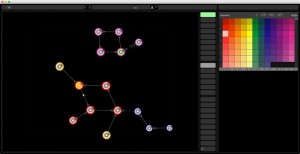 Monomatic’s current project, ‘vertechs.xyz’ is a new type of MIDI music sequencer. Gone is the age-old ‘piano roll’ grid of sequences. In its place, chains of nodes connected by joints. Nodes hold the event data, joints the timing. Chains can form cyclic loops or ‘one-shot’ patterns. They can synchronise with and trigger each other in complex ways using a few discreet types and some simple procedural rules. More than just streamlining the usual repetitive copy and paste workflow with a handful of dynamic patterns, ‘vertechs.xyz’ offers a surprisingly flexible and deceptively powerful approach to making music.
Monomatic’s current project, ‘vertechs.xyz’ is a new type of MIDI music sequencer. Gone is the age-old ‘piano roll’ grid of sequences. In its place, chains of nodes connected by joints. Nodes hold the event data, joints the timing. Chains can form cyclic loops or ‘one-shot’ patterns. They can synchronise with and trigger each other in complex ways using a few discreet types and some simple procedural rules. More than just streamlining the usual repetitive copy and paste workflow with a handful of dynamic patterns, ‘vertechs.xyz’ offers a surprisingly flexible and deceptively powerful approach to making music.
Monomatic’s performance for Seeing Sound 4 showcases ‘vertechs.xyz’ alongside and integrated into a new set of collaborative music and moving image works – including audiovisual remixes of Pfink’s ‘Hypnotised’ – a minimalist dub-techno track that originally featured on Zip Dog Records’ 1998 compilation album ‘Club Meets Dub Vol. 4’ – developed in collaboration with Manchester based illustrator Ian Whadcock; the Donna Summer/Giorgio Moroder 1977 disco classic ‘I Feel Love’ incorporating visuals by the Vienna based graphic design studio Sensomatic; and ‘HY-DRO-GEN’ – an audiovisual interpretation of the visible absorption and emission spectra of the hydrogen atom produced by the discreet excited states of its electron.
Biography
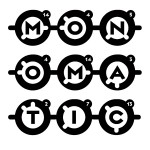 Monomatic was initiated in 2007 as a collaboration, experimental playground and halfway house between the work of Anthony Rowe of squidsoup – art, research and play in creative interaction design using sound, physical and virtual space – and Lewis Sykes then of The Sancho Plan – a progressive audiovisual collective who explore the realtime interaction between music and video. Monomatic has since evolved and the current line up now includes Nick Rothwell a.k.a Cassiel – a composer, performer, software architect, programmer and sound designer and most recently Ben Lycett – a visual artist, filmmaker, technologist and programmer.
Monomatic was initiated in 2007 as a collaboration, experimental playground and halfway house between the work of Anthony Rowe of squidsoup – art, research and play in creative interaction design using sound, physical and virtual space – and Lewis Sykes then of The Sancho Plan – a progressive audiovisual collective who explore the realtime interaction between music and video. Monomatic has since evolved and the current line up now includes Nick Rothwell a.k.a Cassiel – a composer, performer, software architect, programmer and sound designer and most recently Ben Lycett – a visual artist, filmmaker, technologist and programmer.
Monomatic’s earlier physical works investigated rich musical traditions – such as PEAL: A Virtual Campanile – an interactive sound installation commissioned for Sound & Music’s 2009 Expo Leeds festival which modelled the layout and operation of a traditional church bell tower, replacing the bell ropes by an optical sensing system where lasers acted to trigger the ringing process of the individual bells and the Modular Music Box – several interconnected, plug-and-play devices that collectively reproduced the functionality of the familiar 19th century clockwork musical instrument.
Their current real-time, audiovisual performances use custom-made music composition/visualisation software and hardware developed in the creative C++ toolkit openFrameworks and on the Teensy micro-controller development platform – integrated with commercial audio production tools. Monomatic attempt to show a deeper connection between what is heard and what is seen through an amalgam of the audio and visual where there is a more literal ‘harmony’ – a connection between sound and moving image which is more ‘harmonious’, elementary and direct.
Nuno Correia – AVZones
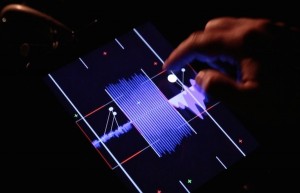 AVZones (2015) is an iPad app for audiovisual performance by Nuno Correia (http://www.nunocorreia.com), composed of an audio sequencer/looper with a visualizer. It explores the interactive potential of a touch screen tablet for integrated musical and visual expression. By default, 3 audiovisual columns or “zones” allow for the manipulation of 3 audio loops. These zones are metaphorical adaptations of channels in a standard audio mixer.
AVZones (2015) is an iPad app for audiovisual performance by Nuno Correia (http://www.nunocorreia.com), composed of an audio sequencer/looper with a visualizer. It explores the interactive potential of a touch screen tablet for integrated musical and visual expression. By default, 3 audiovisual columns or “zones” allow for the manipulation of 3 audio loops. These zones are metaphorical adaptations of channels in a standard audio mixer.
Each zone had 3 XY pads for audio manipulation: pitch shift, delay and filter. Each zone has its own sequencer as well. A visualization of each sound is overlaid on to the respective zone. There are 9 sounds available per zone. Performing different gestures on each XY pad creates different results. The application is scalable: the number of zones, XY pads and sounds can be modified in the code.
In a performance, only the iPad is used for audiovisuals: the visuals from the iPad are projected behind the performer, and the sound comes from the iPad as well. What the performer sees is also what is projected on the screen. The interface is shown in the screen, allowing the audience to better understand the performer’s actions (https://vimeo.com/144976072).
AVZones is open source and work in progress, built with openFrameworks and Maximilian add-on. The app is still being finalized, and will be submitted to the App Store within a few months. Meanwhile, the code is available on GitHub, and the app can be side-loaded manually on an iPad using Xcode 7 (http://github.com/AVUIs/AVZones).
Biography
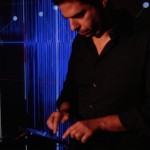 Nuno Correia is a researcher and audiovisual artist. He is interested in interactive multi-sensorial experiences. Since 2000, he has been teaching and conducting research in media art and design, in universities in Portugal, Finland and the UK. Nuno holds a Doctor of Arts degree in new media from Aalto University (Media Lab Helsinki), with the thesis “Interactive Audiovisual Objects”. Currently, he is a researcher at Goldsmiths, University of London (EAVI Group), working on the project “Enabling Audiovisual User Interfaces”, for which he obtained a Marie Curie EU fellowship. Nuno’s work has been presented in more than 20 countries, in such festivals and venues as ACM Multimedia – Interactive Arts (Scottsdale), Electro-Mechanica (St. Petersburg), FILE (São Paulo), ISEA (Istanbul), Le Cube (Paris), Mapping (Geneva), NAME (Lille), Optronica / British Film Institute (London), PixelAche / Kiasma (Helsinki) and SXSW (Austin). Nuno’s projects have been featured in CreativeApplications.Net, CDM, The Creators Project, Leonardo Reviews and Digicult, among other specialized media.
Nuno Correia is a researcher and audiovisual artist. He is interested in interactive multi-sensorial experiences. Since 2000, he has been teaching and conducting research in media art and design, in universities in Portugal, Finland and the UK. Nuno holds a Doctor of Arts degree in new media from Aalto University (Media Lab Helsinki), with the thesis “Interactive Audiovisual Objects”. Currently, he is a researcher at Goldsmiths, University of London (EAVI Group), working on the project “Enabling Audiovisual User Interfaces”, for which he obtained a Marie Curie EU fellowship. Nuno’s work has been presented in more than 20 countries, in such festivals and venues as ACM Multimedia – Interactive Arts (Scottsdale), Electro-Mechanica (St. Petersburg), FILE (São Paulo), ISEA (Istanbul), Le Cube (Paris), Mapping (Geneva), NAME (Lille), Optronica / British Film Institute (London), PixelAche / Kiasma (Helsinki) and SXSW (Austin). Nuno’s projects have been featured in CreativeApplications.Net, CDM, The Creators Project, Leonardo Reviews and Digicult, among other specialized media.
Duncan Chapman, Stewart Collinson, Mike McInerney – Rising Breath
Rising Breath: Stewart Collinson (image), Duncan Chapman (live electronics), Mike McInerney (Shakuhachi)

Full Breath Cycle is a series of performance works for Japanese shakuhachi flute, live video and live electronic sound, each composed in response to a specific installation opportunity, but based on a consistent vocabulary of live shakuhachi performance, live sound manipulation (which combines processing of the shakuhachi signal in real time with precomposed electro-acoustic material) and live video output combined with precomposed drawn film.
The 1st iteration, Empty Breath, an improvised live multi-media performance at the Trafó Arts centre in Budapest, 2005: The 2nd, Turning Breath, performed at SAN Expo’09 in Leeds. The 3rd and 4th iterations, Rising Breath, were performed at the Plymouth ICCI360º Cinema Festival 2009 and Weymouth ICCI360º 2012, the latter as part of the Cultural Olympiad.
For Seeing Sound 2016 the version of Rising Breath will consist of –
Visually: a 2 screen version of 360˚ 5 screen exploration of a costal landscape. Screen 1 – Hand-painted 16mm film, scanned, rotated and sequenced to create transverse movement, Screen 2 – Jitter Patch generating Lissajou figures where the Z axis is displaced by live shakuhachi audio signal.
Audio: Precomposed and live electro-acoustic music with live Shakuhachi processed and diffused. Most of the audio material is sourced from recordings of Shakuhachi attacks and breath sounds recorded in a variety of public and studio spaces.
Biographies
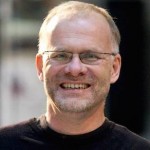 Mike McInerney (www.mikemcinerney.com) is a shakuhachi player and electro-acoustic composer. Recent events include a performance of traditional Zen Hon Kyoku and new duos for guitar and shakuhachi a at the Roselidden wellbeing centre in Cornwall, a new piece for piano and electronics at the Plymouth Contemporary Music Festival 2015 and a touring performance for shakuhachi, drones and Carnatic singer with Duncan Chapman and Supriya Nagarajan. Mike is subject lead in music composition with Plymouth University.
Mike McInerney (www.mikemcinerney.com) is a shakuhachi player and electro-acoustic composer. Recent events include a performance of traditional Zen Hon Kyoku and new duos for guitar and shakuhachi a at the Roselidden wellbeing centre in Cornwall, a new piece for piano and electronics at the Plymouth Contemporary Music Festival 2015 and a touring performance for shakuhachi, drones and Carnatic singer with Duncan Chapman and Supriya Nagarajan. Mike is subject lead in music composition with Plymouth University.
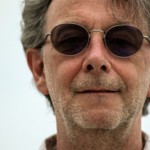 Stewart Collinson is an artist making moving-image work for single-screen, gallery installation and live-performance. Collaboratively, he creates audio/visual work in national and international contexts. He is primarily interested in the interaction of sound and image as a manifestation of collaborative process. He is senior lecturer in moving image on the BA (Hons) Photography and MA Fine Art programmes in the College of Arts at Lincoln University, UK.
Stewart Collinson is an artist making moving-image work for single-screen, gallery installation and live-performance. Collaboratively, he creates audio/visual work in national and international contexts. He is primarily interested in the interaction of sound and image as a manifestation of collaborative process. He is senior lecturer in moving image on the BA (Hons) Photography and MA Fine Art programmes in the College of Arts at Lincoln University, UK.
 Duncan Chapman is a freelance composer / sound artist based in Lincoln UK. Much of his work involves collaborations with groups to create performances, installations and recorded works. Current projects include work with the London Sinfonietta, HCMF, BCMG, Casa da Música (Porto) & the Orchestra of the Royal Opera House. He is currently working with on the touring piece “White Cane” (co-composed with Isabel Jones on Sound And Music’s Composer-Curator project) and creating sounds for Manasamitra’s Lullabies projects in the UK and beyond.
Duncan Chapman is a freelance composer / sound artist based in Lincoln UK. Much of his work involves collaborations with groups to create performances, installations and recorded works. Current projects include work with the London Sinfonietta, HCMF, BCMG, Casa da Música (Porto) & the Orchestra of the Royal Opera House. He is currently working with on the touring piece “White Cane” (co-composed with Isabel Jones on Sound And Music’s Composer-Curator project) and creating sounds for Manasamitra’s Lullabies projects in the UK and beyond.
Marko Ciciliani – Via, for live-electronics, live-video and lighting
In this work for live-electronics, live-video and lighting the performer is entangled in a web of tight connections between sound and image. One of the dominating elements in the video are vertical and horizontal lines that are mirroring the motion of a train of sonic impulses. This motion is also reflected with an arrangement of lighting fixtures that cast moving shadows of the performer on the background of the performance area – again mirroring the motion of the lines on the video and the sonic impulses.
The otherwise immobile performer thereby becomes part of the visual arrangement. Furthermore, at certain points the contours of the performer’s body become part of the video processing, turning the visualization into an extension of the instrument design that drives the piece.
Two underlying synthesis methods that are used in this work. One of them is scanline synthesis, which translates the pixel information from the screen into waveforms that can further be manipulated. This is graphically displayed by a 3D “wheel” that can be rotated by the performer and thereby causes interpolations between five different waveforms that have been gained by the pixel scanning.
The second is pattern-based synchronous grain synthesis, which is suitable to realize rhythmic patters when used at slow speeds, but which can also be accelerated, turning the rhythmic pattern into pitch information. Changes in the rhythmic organization of the pattern then result into timbral differences.
The basic material of the film comes from video recordings of road underpasses, viaducts and interstates in New Zealand and California.
Biography
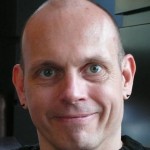 Marko Ciciliani (b. 1970, Zagreb) is a composer, audiovisual artist and researcher based in Austria. The focus of his work lies in the composition of performative electronic music, often in audiovisual contexts. Lighting, laserdesigns or the use of live-video are often integral parts of his compositions. The artistic combination of sound and light was also the topic of his PhD research that he completed at Brunel University London in 2010.
Marko Ciciliani (b. 1970, Zagreb) is a composer, audiovisual artist and researcher based in Austria. The focus of his work lies in the composition of performative electronic music, often in audiovisual contexts. Lighting, laserdesigns or the use of live-video are often integral parts of his compositions. The artistic combination of sound and light was also the topic of his PhD research that he completed at Brunel University London in 2010.
It is characteristic of Ciciliani’s compositions that sound is not only understood as abstract material but as a culturally shaped idiom. The exploration of a sound’s communicative potential is as much in the foreground of his work as its objective sonic quality. Ciciliani’s work is characterized by a conceptual approach in which aspects of classical composition, sound and media-studies play tightly together. His music has been performed in more than 35 countries in Europe, Asia, Oceania and the Americas.
Ciciliani is full Professor for Computer-Music Composition and Sound Design at the IEM – Institute for Electronic Music and Acoustics of the University of Music and Performing Arts Graz. His primary research topics are tightly related to his artistic work and revolve around methods of understanding and analyzing forms of multimedia, and performance practices. In 2015 Ciciliani has been granted funding for a 3 year artistic research project titled “GAPPP – Gamified Audiovisual Performance and Performance Practice”. It is funded as part of the PEEK program of the Austrian Science Fund and will run from 2016-19.
www.ciciliani.com
vimeo.com/channels/cicichannel
gappp.net
Dot Product/Panther Panther – AV set
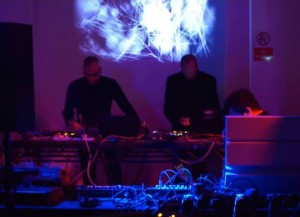 Conceived by Bristol-based producers Adam Winchester and Christopher Jarman, Dot Product is a project which draws upon considered lines of sonic investigation in search of heavy-load-bearing compositions that sport equal amounts of soundsystem pressure and abstract textures. This project is based around sounds derived from frequencies and anomalies commonly inaudible to the human ear. With immersive visuals from Panther Panther, Dot Product comes to light in a swathe of noise, tone, and texture.
Conceived by Bristol-based producers Adam Winchester and Christopher Jarman, Dot Product is a project which draws upon considered lines of sonic investigation in search of heavy-load-bearing compositions that sport equal amounts of soundsystem pressure and abstract textures. This project is based around sounds derived from frequencies and anomalies commonly inaudible to the human ear. With immersive visuals from Panther Panther, Dot Product comes to light in a swathe of noise, tone, and texture.
Biography
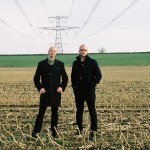 Dot Product is a production duo made up of Adam Winchester (aka Dubstep producer Wedge), and Christopher Jarman, who has previously made Drum & Bass as Raiden, and abstract Techno as Kamikaze Space Programme. While Dot Product’s music nods to all of these styles, their new sound is an abstract affair. Drawing on unusual sound sources to create unsettling dystopian atmospheres. Their sharp-edged, rough-hewn tracks celebrate the eerie mood of industrial music without resorting to the hackneyed clang of sheet metal and machinery. These facets play into their unique creative approach, which truly seeks to yield musicality out of that which was not previously detectable by human senses.
Dot Product is a production duo made up of Adam Winchester (aka Dubstep producer Wedge), and Christopher Jarman, who has previously made Drum & Bass as Raiden, and abstract Techno as Kamikaze Space Programme. While Dot Product’s music nods to all of these styles, their new sound is an abstract affair. Drawing on unusual sound sources to create unsettling dystopian atmospheres. Their sharp-edged, rough-hewn tracks celebrate the eerie mood of industrial music without resorting to the hackneyed clang of sheet metal and machinery. These facets play into their unique creative approach, which truly seeks to yield musicality out of that which was not previously detectable by human senses.
After sharing the initial results of their research, the pair performed select live shows in Bristol and London, as well as being commissioned to create a sonic interpretation of Swedish horror film Let The Right One In. Their self-titled debut album on Osiris Music is the culmination of these initial steps, representing the most complete document of the Dot Product sound to date. The Dot Product LP is available from the 18th of March 2016 on vinyl and digital download.
Tom Richards – Mini-Oramics
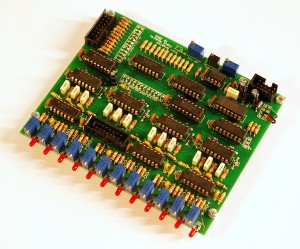 The original Oramics Machine, which is now in the collection of the Science Museum and is unfortunately beyond repair, was an ambitious electronic graphical score reading sequencer/synthesiser created by the composer and technologist Daphne Oram in the mid to late 1960s. This incarnation of Mini-Oramics is a contemporary re-imagining of a later design of Oram’s, which she had planned to launch as a commercial/educational product.
The original Oramics Machine, which is now in the collection of the Science Museum and is unfortunately beyond repair, was an ambitious electronic graphical score reading sequencer/synthesiser created by the composer and technologist Daphne Oram in the mid to late 1960s. This incarnation of Mini-Oramics is a contemporary re-imagining of a later design of Oram’s, which she had planned to launch as a commercial/educational product.
This new device has been created to provide insight into the feasibility of Oramics as an interface, and to enquire whether the painstaking nature of programming such a machine was worth the extra degree of compositional nuance it might have provided, given the tools available to the early 1970s electronic musician. It is also hoped that composers will embrace the challenge of working with Oramics for the first time in forty years.
Biography
 Tom Richards is an artist, musician, researcher and instrument designer working in London UK. Since graduating with an MA in Fine Art from Chelsea College of Art in 2004, he has built a practice using electronics, sound and film, and has exhibited and performed widely in the UK, as well as internationally in the US, Germany and Sweden. Selected works and live performances have taken place at Tate Britain, The Queen Elizabeth Hall, The Science Museum, Spike Island, Cafe Oto, MK Gallery, Bold Tendencies, Camden Arts Centre, Resonance FM and NTS radio. He is currently studying between Goldsmiths and the Science Museum for a practice led PhD on the life and work of Daphne Oram: electronic music pioneer, and founder member of the BBC Radiophonic Workshop.
Tom Richards is an artist, musician, researcher and instrument designer working in London UK. Since graduating with an MA in Fine Art from Chelsea College of Art in 2004, he has built a practice using electronics, sound and film, and has exhibited and performed widely in the UK, as well as internationally in the US, Germany and Sweden. Selected works and live performances have taken place at Tate Britain, The Queen Elizabeth Hall, The Science Museum, Spike Island, Cafe Oto, MK Gallery, Bold Tendencies, Camden Arts Centre, Resonance FM and NTS radio. He is currently studying between Goldsmiths and the Science Museum for a practice led PhD on the life and work of Daphne Oram: electronic music pioneer, and founder member of the BBC Radiophonic Workshop.
Andrea Szigetvári – CT
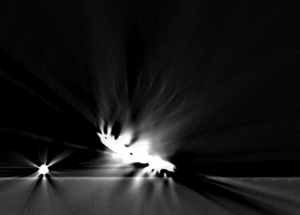 CT is based on Zsolt Gyenes’ 1.5 minustes long computer tomograph animation. Computer tomography (CT) is a medical imaging method employing tomography created by computer processing. If properly used, the “object” normally is the human body. In case of “improper use” different objects (like wires in this case) placed in the tomograph, photographed and animated, create unexpected results in form of abstract moving images. The animation does not have any particular meaning, it works like a Rochard test, where the expressive qualities, meanings are added by the subjects. The music serves here as a tool to particularize the expressivity of the visual system.
CT is based on Zsolt Gyenes’ 1.5 minustes long computer tomograph animation. Computer tomography (CT) is a medical imaging method employing tomography created by computer processing. If properly used, the “object” normally is the human body. In case of “improper use” different objects (like wires in this case) placed in the tomograph, photographed and animated, create unexpected results in form of abstract moving images. The animation does not have any particular meaning, it works like a Rochard test, where the expressive qualities, meanings are added by the subjects. The music serves here as a tool to particularize the expressivity of the visual system.
Different sonic interpretations of the same visual gestures are produced by an interactive music system, which parameters are modified in real time by the performer. A multidimensional timbre space was created allowing to navigate between different sonorities and musical expressions.
The music is controlled with the data extracted from the analysis of the video. The video is performed real time: simetimes the 1.5 minutes is played as it is, sometimes the sequence of frames controlled manually or with a help of directed randomness and loops.The piece has an open form put together from fragments of directed improvisations.
CT was realized and is performed by MAX/MSP/Jitter software.
Biography
Andrea Szigetvári is an electroacoustic music composer. Her creative and research work concentrate mainly on the role of the timbre in new music, synchresis in audiovisual art and interactive performance.
She studied sound recording and electroacoustic music at Fr. Chopin Academy of Music in Warsaw. She was a Fulbright researcher in the USA at Brooklyn College and later at CCRMA, Stanford. She holds a DLA in composition from the Liszt F. Academy of Music Budapest. In 2001 she received two “Prix” of the a Bourges Electroacoustic Music Competition in ‘multimedia’ and ‘sound art’ categories.
She is the funder of the Hungarian Computer Music Foundation which aim is support contemporary electroacoustic music in Hungary. She has been the organizer and performer of many international collaborations, festivals, conferences.
She has taught electroacoustic music composition at the Liszt F. Academy of Music in Budapest, where she founded the Electronic Music Media Art Course in 2011.. She is the lecturer also at the Pécs University of electroacoustic music, at the Metropolitan University, Budapest at the Moving Image and Sound course.
Sama Mara/Lee Westwood – A Hidden Order
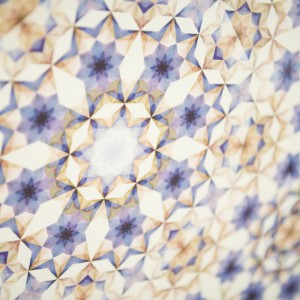 What would pattern sound like if interpreted as a rhythm or melody? How would music look if transposed into the visual realm? “A Hidden Order is an extraordinary fusion of geometry and music. It is a magical duet that realises Plato’s dream.” Marcus du Sautoy A Hidden Order presents an innovative artistic venture revealing the bonds between Art & Music, bringing to light an unforeseen unity that merges the worlds of Traditional Islamic Art & Western Contemporary Composition. All aspects of A Hidden Order can be seen to come to life during the live audio-visual performance. The sounds of the instruments are translated into real-time graphics through our bespoke computer program. Here we are privy to the entire process, witnessing the clear relationship between sound and form as the performer recreates artworks from music before our eyes and ears. Rhythmically driven, with a strong melodic thread, the music traverses the realms of contemporary composition, with the striking syncopations and harmonies of folk and jazz never far away. Yet amongst all of this, behind the face of the music, there is another, very different guiding force: each piece is meticulously crafted to produce a unique image, following rigorous geometric principles which relate the fundamental elements of the visual realm to those of sound, at the same time never losing sight of its musical integrity.
What would pattern sound like if interpreted as a rhythm or melody? How would music look if transposed into the visual realm? “A Hidden Order is an extraordinary fusion of geometry and music. It is a magical duet that realises Plato’s dream.” Marcus du Sautoy A Hidden Order presents an innovative artistic venture revealing the bonds between Art & Music, bringing to light an unforeseen unity that merges the worlds of Traditional Islamic Art & Western Contemporary Composition. All aspects of A Hidden Order can be seen to come to life during the live audio-visual performance. The sounds of the instruments are translated into real-time graphics through our bespoke computer program. Here we are privy to the entire process, witnessing the clear relationship between sound and form as the performer recreates artworks from music before our eyes and ears. Rhythmically driven, with a strong melodic thread, the music traverses the realms of contemporary composition, with the striking syncopations and harmonies of folk and jazz never far away. Yet amongst all of this, behind the face of the music, there is another, very different guiding force: each piece is meticulously crafted to produce a unique image, following rigorous geometric principles which relate the fundamental elements of the visual realm to those of sound, at the same time never losing sight of its musical integrity.
Biographies
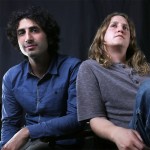 Sama Mara is an artist and geometer based in London. He was awarded the Barakat Trust Prize at the Prince’s School of Traditional Arts where he graduated with an MA in Traditional Arts. He completed his BA in Music and Visual Performance in the University of Brighton. Sama has a wide range of skills and interests including traditional geometry, programming, painting, music theory, studio photography, video editing, fractal geometry and quasi-crystals, all of which inform, inspire, and enable his practice as an artist. His project A Hidden Order made in collaboration with composer Lee Westwood has seen his work exhibited across the globe including London, Istanbul, Abu Dhabi, Miami, Los Angeles, Toronto, Seoul and Jeddah. www.samamara.com Described by the Musician’s Union as “one of the UK’s most exciting and versatile musicians”, Lee Westwood is a guitarist and composer whose wide-ranging output stems from a long-term tenacity for musical exploration. Lee studied composition with James Weeks, Martin Suckling, Martin Butler and Alison Kay. He is currently an LSO Soundhub composer, and has been one of Sound & Music’s ‘New Voices’ Composers two years running. Lee has toured his own music throughout the UK and Europe, and has released an extensive back-catalogue of solo albums. As a guitarist, Lee performed for 5 years with Songlines Award nominees Dizraeli & The Small Gods, and currently tours and records with experimental trio Le Juki. www.lee-westwood.com
Sama Mara is an artist and geometer based in London. He was awarded the Barakat Trust Prize at the Prince’s School of Traditional Arts where he graduated with an MA in Traditional Arts. He completed his BA in Music and Visual Performance in the University of Brighton. Sama has a wide range of skills and interests including traditional geometry, programming, painting, music theory, studio photography, video editing, fractal geometry and quasi-crystals, all of which inform, inspire, and enable his practice as an artist. His project A Hidden Order made in collaboration with composer Lee Westwood has seen his work exhibited across the globe including London, Istanbul, Abu Dhabi, Miami, Los Angeles, Toronto, Seoul and Jeddah. www.samamara.com Described by the Musician’s Union as “one of the UK’s most exciting and versatile musicians”, Lee Westwood is a guitarist and composer whose wide-ranging output stems from a long-term tenacity for musical exploration. Lee studied composition with James Weeks, Martin Suckling, Martin Butler and Alison Kay. He is currently an LSO Soundhub composer, and has been one of Sound & Music’s ‘New Voices’ Composers two years running. Lee has toured his own music throughout the UK and Europe, and has released an extensive back-catalogue of solo albums. As a guitarist, Lee performed for 5 years with Songlines Award nominees Dizraeli & The Small Gods, and currently tours and records with experimental trio Le Juki. www.lee-westwood.com
Andrew Duff – Vectrex and Eurorack study #X ‘Performance v1’
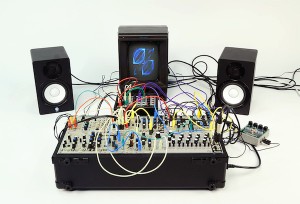 Using a hacked and modified early 1980s games console vector CRT screen, the work presents audio generated oscillographics that respond to an immersive and meditative, noise and drone soundscape performed with a modular synthesiser.
Using a hacked and modified early 1980s games console vector CRT screen, the work presents audio generated oscillographics that respond to an immersive and meditative, noise and drone soundscape performed with a modular synthesiser.
Referencing influential and pioneering work by Ben Laposky, Steve Rutt & Bill Etra, and performances by Russell Haswell, this project explores, manipulates and combines audio/visual abstractions created through the interplay of the system, its boundaries and limitations, and the user/performers interactions and aesthetic choices.
Biography
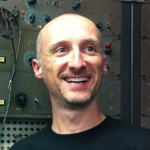 Andrew Duff is a sound artist and organiser of the University of Sussex based Brighton Modular meets. Since the late 1980s, Andrew has amassed a large collection of electronic music, and collected, hacked and experimented with a range of, generally, Japanese analogue synthesizers, DJing, recording music and performing live at club nights and various other events. Since completing a Masters in Design and Digital Media in 2000, he has been involved in teaching and academic research, whilst developing his own work.
Andrew Duff is a sound artist and organiser of the University of Sussex based Brighton Modular meets. Since the late 1980s, Andrew has amassed a large collection of electronic music, and collected, hacked and experimented with a range of, generally, Japanese analogue synthesizers, DJing, recording music and performing live at club nights and various other events. Since completing a Masters in Design and Digital Media in 2000, he has been involved in teaching and academic research, whilst developing his own work.
Frieda Abtan – Flight of Birds
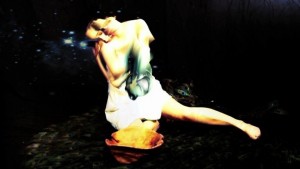 Flight of Birds is a body of audiovisual work for performance that draws on notions of anima and of spiritual transformation. The narrative is inspired by traditional Yoruban mythology in which a woman’s spirit may leave her body to travel outside in the form of a bird. Here, a woman longs for flight, staring into a birdcage for the mysteries within. We see her dressed as a bird, dancing, unfolding, but never quite leaving the ground. Darker, winged creatures haunt the air around her. Eventually, she is transformed. She visits the sky, not as a bird, but as a constellation.
Flight of Birds is a body of audiovisual work for performance that draws on notions of anima and of spiritual transformation. The narrative is inspired by traditional Yoruban mythology in which a woman’s spirit may leave her body to travel outside in the form of a bird. Here, a woman longs for flight, staring into a birdcage for the mysteries within. We see her dressed as a bird, dancing, unfolding, but never quite leaving the ground. Darker, winged creatures haunt the air around her. Eventually, she is transformed. She visits the sky, not as a bird, but as a constellation.
Flight of Birds explores the multiple ways that movement and form can be abstracted through surface and temporal manipulation, as well as the defining sensory relationship that exists between sound and image in time-based composition. Freida Abtan composed Flight of Birds with footage of Audrey Ellis Fox and Bonnie Johnson while pursuing her PhD at Brown University in Providence, Rhode Island, USA.
Biography
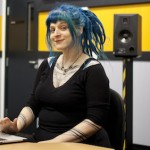
Freida Abtan is a Canadian composer and visual artist currently living in London, UK where she leads the Music Computing programme at Goldsmiths, University of London. Her sound work descends from formal electro-acoustic composition strategies and from the great body of experimental electronic music that concentrates on the exploration of the spectral properties of sound. She primarily works with samples of both musical and non-musical objects that she records herself and then manipulates, often beyond recognition, through techniques derived from musique concrete and through successive layers of digital signal processing.
Daniela de Paulis (CAMRAS/ASTRON) – OPTICKS
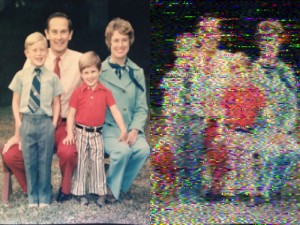 OPTICKS is a Cosmic Mail Art happening between the Earth and the Moon, during which images are transmitted to the Moon and back as radio signals in real time. The project has been realized by visual artist Daniela de Paulis (IT/NL) in collaboration with radio amateur Jan van Muijlwijk and the CAMRAS radio amateurs association based at the Dwingeloo radio telescope (NL). Each live performance is made possible thanks to the collaboration of international radio enthusiasts, including Bruce Halasz (Brazil) and Nando Pellegrini (IT). During each live performance of OPTICKS, the images are converted into radio waves and are transmitted to the Moon. The Moon’s surface reflects the radio signals and scatters them all around the Space. Only a small percentage of the original signal is reflected back on Earth and received by the Dwingeloo radio telescope’s antenna, where it is converted back into the original images. The ‘noise’ showing in any Moon reflected image is caused by the great distance travelled by the radio signals to the Moon and back and by the poor reflective qualities of the Moon’s surface. The title OPTICKS is inspired by Newton’s discoveries of the light spectrum, reflection and refraction. Similarly, the colours composing an image – converted into radio signals – are bounced off the Moon (reflected and refracted) by its surface during each live performance.
OPTICKS is a Cosmic Mail Art happening between the Earth and the Moon, during which images are transmitted to the Moon and back as radio signals in real time. The project has been realized by visual artist Daniela de Paulis (IT/NL) in collaboration with radio amateur Jan van Muijlwijk and the CAMRAS radio amateurs association based at the Dwingeloo radio telescope (NL). Each live performance is made possible thanks to the collaboration of international radio enthusiasts, including Bruce Halasz (Brazil) and Nando Pellegrini (IT). During each live performance of OPTICKS, the images are converted into radio waves and are transmitted to the Moon. The Moon’s surface reflects the radio signals and scatters them all around the Space. Only a small percentage of the original signal is reflected back on Earth and received by the Dwingeloo radio telescope’s antenna, where it is converted back into the original images. The ‘noise’ showing in any Moon reflected image is caused by the great distance travelled by the radio signals to the Moon and back and by the poor reflective qualities of the Moon’s surface. The title OPTICKS is inspired by Newton’s discoveries of the light spectrum, reflection and refraction. Similarly, the colours composing an image – converted into radio signals – are bounced off the Moon (reflected and refracted) by its surface during each live performance.
Biography
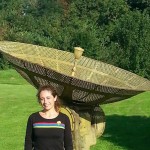 Daniela de Paulis is an interdisciplinary artist based in The Netherlands. She exhibits internationally, often collaborating with other artists, scientists and radio amateurs. She holds a BA from the Academy of Fine Arts in Rome, Italy, and a Master Degree in Media Arts from Plymouth University, UK. Since October 2009 she is the first artist in residence at the Dwingeloo radio telescope and ASTRON (www.astron.nl) where she developed, together with the CAMRAS and the ASTRON team, a technology called Visual Moonbounce. She is currently a guest researcher at ASCA (Amsterdam School for Cultural Analysis), University of Amsterdam, developing her research on Interstellar Transmissions. Since 2010 she has been collaborating with the international collective Astronomers Without Borders (AWB), as the founder and director of the AstroArts programme. In 2013 she founded Cabine Voltaire, a pioneering online, collaborative platform for live debates on science, technology and the humanities. She is a reviewer for the Leonardo MIT Journal and the EVA (Electronic Visualization in the Arts) London conference, as well as a regular contributor for Astronomers Without Borders and www.astroblogs.nl amongst others. She has published her work with the Leonardo MIT Journal, Inderscience, Acta Astronautica and Cambridge University Press. She is a member of the international SETI (Search for Extraterrestrial Intelligence) committee as the speaker for SETI and culture.
Daniela de Paulis is an interdisciplinary artist based in The Netherlands. She exhibits internationally, often collaborating with other artists, scientists and radio amateurs. She holds a BA from the Academy of Fine Arts in Rome, Italy, and a Master Degree in Media Arts from Plymouth University, UK. Since October 2009 she is the first artist in residence at the Dwingeloo radio telescope and ASTRON (www.astron.nl) where she developed, together with the CAMRAS and the ASTRON team, a technology called Visual Moonbounce. She is currently a guest researcher at ASCA (Amsterdam School for Cultural Analysis), University of Amsterdam, developing her research on Interstellar Transmissions. Since 2010 she has been collaborating with the international collective Astronomers Without Borders (AWB), as the founder and director of the AstroArts programme. In 2013 she founded Cabine Voltaire, a pioneering online, collaborative platform for live debates on science, technology and the humanities. She is a reviewer for the Leonardo MIT Journal and the EVA (Electronic Visualization in the Arts) London conference, as well as a regular contributor for Astronomers Without Borders and www.astroblogs.nl amongst others. She has published her work with the Leonardo MIT Journal, Inderscience, Acta Astronautica and Cambridge University Press. She is a member of the international SETI (Search for Extraterrestrial Intelligence) committee as the speaker for SETI and culture.